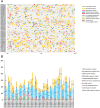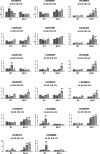Identification, characterization and expression profiles of E2 and E3 gene superfamilies during the development of tetrasporophytes in Gracilariopsis lemaneiformis (Rhodophyta)
- PMID: 37723489
- PMCID: PMC10506303
- DOI: 10.1186/s12864-023-09639-0
Identification, characterization and expression profiles of E2 and E3 gene superfamilies during the development of tetrasporophytes in Gracilariopsis lemaneiformis (Rhodophyta)
Abstract
E2 ubiquitin conjugating enzymes and E3 ubiquitin ligases play important roles in the growth and development of plants and animals. To date, the systematic analysis of E2 and E3 genes in Rhodophyta is limited. In this study, 14 E2 genes and 51 E3 genes were identified in Gracilariopsis lemaneiformis, an economically important red alga. E2 genes were classified into four classes according to the structure of the conserved domain, UBC. E3 genes were classified into 12 subfamilies according to individual conserved domains. A phylogenetic tree of seven algae species showed that functional differentiation of RING-type E3s was the highest, and the similarity between orthologous genes was high except in Chlamydomonas reinhardtii and Chara braunii. RNA-seq data analysis showed significant differential expression levels of E2 and E3 genes under the life stages of tetraspore formation and release, especially GlUBCN and GlAPC3. According to GO and KEGG analysis of two transcriptomes, GlUBCN and GlAPC3 were involved in ubiquitin-mediated proteolysis, and other subunits of the anaphase promoting complex or cyclosome (APC/C) and its activators GlCDC20 and GlCDH1 were also enriched into this process. The CDH1 and CDC20 in 981 were down-regulated during tetraspores formation and release, with the down-regulation of CDH1 being particularly significant; CDH1 and CDC20 in WLP-1, ZC, and WT were up-regulated during tetraspores formation and release, with CDC20 being more significantly up-regulated. Therefore, GlCDH1, rather than GlCDC20, in '981' might play the leading role in the activation of the APC/C, and GlCDC20 might play the leading role rather than GlCDH1 in strains WLP-1, ZC and wild type. The low fertility of cultivar 981 might be highly correlated with the inactivity of activators CDH1 and CDC20. This study provided a basic and comprehensive understanding of characteristic of E2 and E3 genes in Gp. lemaneiformis and set a foundation for further understanding of E2 ubiquitin conjugating enzymes and E3 ubiquitin ligase in regulating tetrasporophytes development of Gp. lemaneiformis.
Keywords: E2 ubiquitin conjugating enzymes; E3 ubiquitin ligases; Gracilariopsis lemaneiformis; Tetrasporophytes development and tetraspores release.
© 2023. BioMed Central Ltd., part of Springer Nature.
Conflict of interest statement
The authors declare no competing interests.
Figures


















Similar articles
-
Studies on the regulation of E3 ubiquitin ligase APC3 and its interacting proteins on the tetraspore formation and release in Gracilariopsis lemaneiformis (Rhodophyta).Plant Sci. 2025 Jul;356:112488. doi: 10.1016/j.plantsci.2025.112488. Epub 2025 Mar 30. Plant Sci. 2025. PMID: 40169068
-
Cloning of ubiquitin-activating enzyme and ubiquitin-conjugating enzyme genes from Gracilaria lemaneiformis and their activity under heat shock.Gene. 2014 Mar 15;538(1):155-63. doi: 10.1016/j.gene.2013.12.017. Epub 2013 Dec 21. Gene. 2014. PMID: 24365593
-
TPR subunits of the anaphase-promoting complex mediate binding to the activator protein CDH1.Curr Biol. 2003 Sep 2;13(17):1459-68. doi: 10.1016/s0960-9822(03)00581-5. Curr Biol. 2003. PMID: 12956947
-
Ubiquitin-conjugating enzyme E2C: a potential cancer biomarker.Int J Biochem Cell Biol. 2014 Feb;47:113-7. doi: 10.1016/j.biocel.2013.11.023. Epub 2013 Dec 17. Int J Biochem Cell Biol. 2014. PMID: 24361302 Review.
-
Functional characterization of Anaphase Promoting Complex/Cyclosome (APC/C) E3 ubiquitin ligases in tumorigenesis.Biochim Biophys Acta. 2014 Apr;1845(2):277-93. doi: 10.1016/j.bbcan.2014.02.001. Epub 2014 Feb 22. Biochim Biophys Acta. 2014. PMID: 24569229 Free PMC article. Review.
Cited by
-
Cullin-Conciliated Regulation of Plant Immune Responses: Implications for Sustainable Crop Protection.Plants (Basel). 2024 Oct 26;13(21):2997. doi: 10.3390/plants13212997. Plants (Basel). 2024. PMID: 39519916 Free PMC article. Review.
References
MeSH terms
Substances
LinkOut - more resources
Full Text Sources
Miscellaneous

